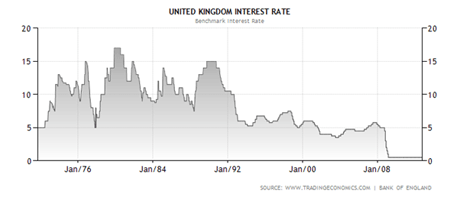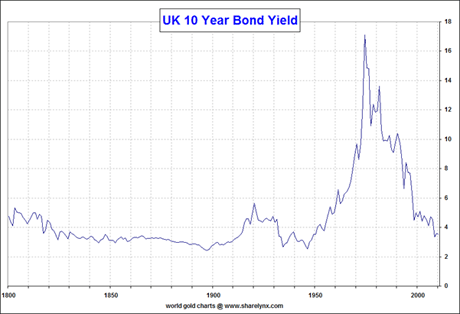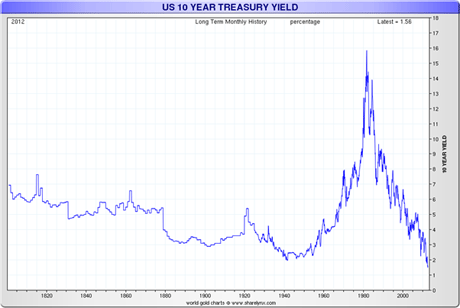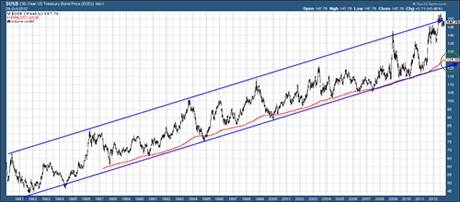Hope you had a happy Halloween!
This weekend I read Conservative MP Doug Carswell’s, The End Of Politics.
I recommend it. It will fill you with optimism.
Carswell describes how the shrinking of the state is inevitable. The collective intelligence generated by the digital age means it will just not be possible for states to operate in the opaque, suffocating and expensive way that they do.
The tax receipts will no longer be there. The possibility of endless government borrowing will not be there. And the option to inflate the currency will not be there as, thanks to digital alternatives, governments will lose their monopolies on money.
So the state must shrink or die.
If he’s right – and I hope he is – the world will be a better place for it.
But I fear we’ve a long way to go before we reach any such golden age. And in the meantime investors need to be prepared for a painful transition.
Welcome to the Great Stagnation
Nobody can say for sure what would have happened if governments and central banks had acted differently in 2008. What if the banks had not been bailed out? And what if central banks had not chosen massive economic and financial intervention?
I like to think that asset prices would have fallen considerably lower, that a free-er and fairer system of money and finance would have emerged and that economies would now be growing in a much healthier way. But neither I, nor anybody else, can prove what might have been.
Now a feeling of stagnation and limbo pervades. Politics is mired in debates over whether stimulus and spending or cutbacks are the answer. Businesses are reluctant to borrow and invest. Banks are reluctant to lend. The housing market has atrophied. Stocks are neither compellingly expensive, nor compelling cheap, stuck in a cycle of panic followed by stimulus. And investment decisions are being made often not on the merits or otherwise of a company, but on how inflationary the actions of a central banker are anticipated to be.
In the late 1970s and early ’80s, governments were forced to take certain measures because they had lost control of currencies, interest rates were spiralling and the bond vigilantes were forcing them down a certain path. But that is not the case now. The bond markets are still in bull mode.
We won’t see Carswell’s “end of politics” – or the Great Purging that was avoided in 2008 – until we get a reversal in bonds. The big question is, when, if ever, will we get that turn?
Have bond markets peaked?
In the UK, the Bank of England is now buying 50% of UK gilts – and, effectively, printing the money to do so. It’s an artificial situation, but that doesn’t mean it can’t carry on. I’ve called the top in bonds before and been wrong. Look at Japan if you want to get an idea of how long these things can go on for – 23 years and counting since the crash of 1989. Gilts are perceived as a safe haven, even real inflation is higher than the yield they pay.
Here’s a chart of UK interest rates since the 1970s. They continue to be the lowest they’ve been in history.

And here, thanks to Nick Laird of sharelynx.com we see ten-year yields. I must say I am surprised to see that they are not quite at all-time lows.

The longer this artificial stimulus carries on, I’d say the more inflation is being stored up for further down the road. Once rates do start to rise, the chances are prices will run far ahead of them.
Turning now to the US, we see the yields on ten-year Treasuries are even lower.

Next we see a chart of the 30-year bond price.

This is a bull market that began in 1982. It’s extremely orderly and well behaved – as you can see by the two blue tram lines. Using a dotted red line I have also marked the 377-week exponential moving average (the average price of the last 377 weeks, exponential meaning recent weeks carry more weight ). A 377-week average might seem an odd average to use, but it works beautifully, as you can see. Every few years it comes back there to find long-term support.
The next move for bond prices
The current bond price of 148 is less than 5% off the all-time high of 153 which came earlier this year. We are trading near the top of a well-defined range and I see a return to the 123-5 area as a distinct possibility (see the green circle on the graph) over the next year or so.
But, in such an event, that structure I have drawn would still be intact, even though such a move would add pressure. While that structure remains, it’ll be business as usual. Limbo continues.
But the game changes, in my view, if we sink below those levels, below that lower rising blue line. That’s when rates start to rise, debt becomes much harder to service, defaults increase, governments lose control, perhaps they print more, raise taxes even further – and we head into Carswell’s “end of politics”.
If you want to play bond prices, most spread-betting firms offer bets and CFDs that track them. You can also buy government bonds although this is a route best suited to experienced investors. Besides I don’t tend to buy bonds directly as I don’t like the way the government spends my money!
Of course, if we do ever get bond market mayhem and Carswell’s “end of politics”, gold will be very much the place to be. Perhaps that’s when we see its much touted final blow-off phase. After that the green shoots of economic – or Kondratieff spring – will come through.
Finally, I would like to thank all of you who have pre-ordered my book: Life after the state. Last week, I’m delighted to say, we got it fully funded. I am very grateful and very excited. As you can imagine, being called Life After The State, it covers a lot of similar ground to Carswell’s End Of Politics which now means I now have to get my head down and do some heavy re-writing, before the book heads into pre-production and printing.
Category: Market updates

